SLR with focal plane shutter
The system of focal plane shutter cameras for 35mm film has established itself as the standard for reflex cameras since 1960.
Even before the Second World War, Zeiss Ikon in Dresden was working on a single-lens reflex camera based on the Contax. However, due to the destruction of the development department, all prototypes and design documents were lost. When two companies in East and West Germany were founded under the name Zeiss Ikon after the end of the war, there was initially a dispute over the rights to the name. Zeiss Ikon in Stuttgart won the prestigious company logo. In Dresden, on the other hand, the first German SLR camera with focal plane shutter and fixed pentaprism was developed and presented in 1948.

This camera can certainly be considered an example of successful construction. Introduced as the „Contax S“ (for SLR), it still looks modern today. It’s no bigger or heavier than the CONTAX rangefinder camera – it would still pass as a compact SLR today. You accept that the viewfinder image gets terribly dark towards the corners, there is still no swing-back mirror (and will never be installed) and the shutter speed setting with the little wheel and slider is somehow strange (and prone to failure). The M42 screw thread isn’t that elegant either, but hello: almost all lenses from Carl Zeiss Jena, Meyer Görlitz and others can be used. But first it takes more than a year for the camera to go into production, then there are legal disputes about the name. And then there is hardly any real model maintenance going on. 1956 the last further development: camera-operated internal release of the spring diaphragm and a Fresnel lens under the prism. This also effectively brightens the rather dark viewfinder image, larger control buttons and a modified shutter mechanism are gradually being installed. Until 1958, only models sold in the GDR or the Eastern Bloc were allowed to bear the name Contax, after that all models were called Pentacon. Despite all of this, my Contax F is a camera with which you can shoot first-class photos. The standard Tessar is in no way inferior to the West German types in terms of sharpness, the M42 screw connection is not a disadvantage as there are still numerous inexpensive top lenses to buy and the 50s ambience is simply priceless.
Then we come to the first focal plane shutter reflex camera from Zeiss Ikon. As the successor to the legendary Contax rangefinder cameras, this machine had to offer something sensational from the start. Customers were not disappointed either: In 1959, Zeiss Ikon presented the Contarex.

Whole books have been written about this camera, so that anyone who is interested in this device, which is still spectacular today, finds it easy to obtain comprehensive information. Just a few key data: The Contarex weighs 910 grams without the lens and consists of around 1500 individual parts. The price when it was introduced in 1959 was 1400 DM and rose to 1800 DM by 1966 (with Planar 2/50 mm). It is questionable whether the Zeiss Ikon company ever made any money with this highly complicated camera. When it was introduced in 1959, the Contarex was way ahead of its time thanks to its advanced aperture control and coupled exposure metering. It was also sensational that many areas of photography could be opened up with just a few accessories. The Planar 1:2/50mm lens supplied as standard was by far the best universal lens of its time with a close-up limit of 30cm and excellent imaging performance. All of the other lenses developed for the Contarex were also tops in their class. Special types of glass ensure uniform color rendering within the series. At the end of production, the palette ranged from the 18mm wide-angle lens to the 1000mm mirror telephoto. The prices were kept like that ordinary consumers could only marvel.

A useful accessory for the macro photographer is the bellows device, with which objects can be photographed with almost any magnification. The Zeiss Ikon device is characterized by excellent stability and precise adjustability. All lenses from 35mm can be used. Photographing with a bellows device and long focal length lenses is particularly appealing, as the extended close-up range opens up new perspectives.
When the sales figures at Zeiss Ikon deteriorated dramatically in the mid-1960s, the company management relied on a development by Voigtländer, which was already ready for series production in 1963.

Within a few months, a rather bulky single-lens reflex camera was constructed from the pleasing Voigtländer design of the Bessaflex.
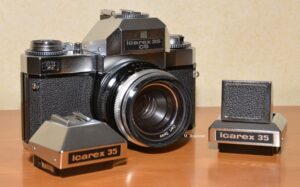
This „beginner’s camera“, priced below the Contaflex, was to regain market share from the competition from 1966 onwards. The Icarex 35, as the first model was called, was by no means a lasting success. The equipment was too meager, the standard lens too weak: a three-lens Pantar with a f/2.8 aperture. The starting price of approx. 400 DM was kept low, but the surcharges for a sharp Tessar or even Ultron lens did not make the camera any more attractive due to the lack of an exposure meter. It was quickly „improved“. A viewfinder unit with an uncoupled exposure meter was added to the program (at steep prices), and then the Icarex 35 S came in 1967
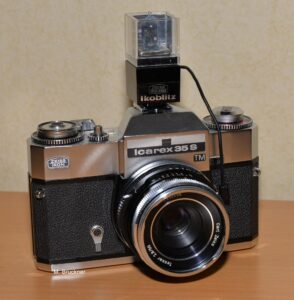
with built-in exposure meter. However, this was tied to the working aperture, other manufacturers had had such in their range for 5 years for less money. Real progress looked different. In 1969, out of sheer desperation, the Icarex program was expanded to include M42 screw thread versions in order to attract potential changers from the Pentacon/Praktica camp. You have to imagine that: Zeiss Ikon/Voigtländer manufactured five different SLR cameras under one roof (Contaflex, Contaflex 126, Icarex, Contarex, Bessamatic/Ultramatic) that were not compatible in their interchangeable lenses. The production and storage costs were no longer commercially calculable. When the losses exceeded 10 million in 1971, the Zeiss Ikon/Voigtländer company went bankrupt. That doesn’t mean that the Icarex is a bad camera, on the contrary. Only brought onto the market years too late and then developed hesitantly and not user-friendly out of consideration for the Contarex (which hardly anyone bought anyway).
The Pentax Spotmatic, introduced in 1962, shows how it could have been done better:
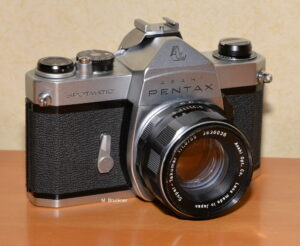
It can do everything that the Icarex can do, at a lower price and 1/3 less weight with better quality. The M42 connection for the lens gives access to good lenses that are still affordable today, the CdS light measurement is quite accurate and the housing size is a good compromise between handy and solid.
A side remark: in 1968 the German photo industry achieved a sales increase of 3.5% worldwide, while the Japanese competition achieved an increase of 65%. This was by far not only due to the lower sales prices. The Pentax Spotmatic was also a popular tool for professional photographers because of its almost legendary robustness.
In the mid-1960s, the Wetzlar camera manufacturer Leitz, which had made history with its rangefinder cameras, was also looking for new sales markets. This is where the SLR concept, with its wide range of options, came in handy for keeping up with the competition.
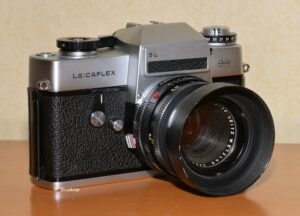
In 1968 the Leicaflex SL came onto the market with TTL light metering. It offered a kind of selective metering, which essentially corresponds to a spot metering with a slightly larger measuring field. For years this was a feature that the Leicaflex had to itself. The housing now showed a clear form, without the original embossing for the selenium light meter for outdoor measurement being recognizable. The appropriate lenses require a so-called 2-cam control in order to be suitable for exposure metering through the lens. The Leicaflex SL was delivered with a light or black chrome finish as standard; only a few copies were painted black. The total production amounts to about 72,000 units, of which almost 1,100 were designed for operation with the optionally available SL engine. Equipped with a battery adapter for the mercury button cells that are no longer available, the Leicaflex SL still impresses today with precise light measurement, excellent lenses and high-quality handling.

As the top model of the popular A series, Canon offered the A-1 from 1978. The A-1 gained special importance because it was the first to have a fully automatic mode, in which the aperture value and shutter speed are automatically determined by the camera’s microprocessor. It was also the first camera in which the shutter speed and aperture value are displayed using red 7-segment LEDs in the viewfinder area. The Canon A-1 is a robust workhorse with an adjustable shutter speed range from 30sec to 1/1000sec. Thanks to the hassle-free automatic functions and the excellent viewfinder, taking photos with the A1 is a pure pleasure.
After a long search, I found a well-preserved copy of my first SLR camera, the Canon T 80.

It was a special offer from Foto Porst in 1988. For DM 499 the buyer got a fully automatic autofocus camera with the standard lens AC 1.8/50mm. What many customers, including me, didn’t know: the T 80 was a dead swan, production stopped in 1986. There were two specially built AF zoom lenses for the camera, but these were hardly ever offered in Germany. (The internet didn’t even exist yet!) The device is built as a pure machine with the option of selecting 5 different motif types in order to influence the program characteristics. There is an exposure compensation switch for shots with a bright background.

Luckily, all Canon FD lenses (also from other manufacturers) that can be manually focused could be connected. A beep then showed whether the targeted object was in focus. All in all a very reliable camera with which it is quite easy to take good pictures. If you only want to think about the motif design but not about apertures or time settings, the Canon T 80 is the best choice.
After I finally found „my“ T 80 again, I realized that the T-models had actually reached a status worthy of being collected. They form the end of the venerable Canon FD bayonet, which appeared in its original form in 1959.
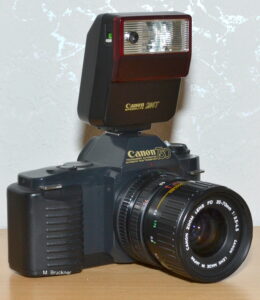
The entry-level model Canon T 50 presented in 1983 had an automatic program that the photographer could not influence except for flash shots with 1/60s. In the viewfinder, a green >P< gave information about the status of the exposure. (flashing, not flashing) The times are set from 2sec to 1/1000sec. selected automatically, with the automatic mode preferring a medium aperture. Focusing is done via a very bright viewfinder screen with split image indicator and microprism ring. The film is transported with the built-in motor, and it is rewound with a crank. An ideal device for all photographers who don’t want to worry about aperture and shutter speed at all and who rely on the admittedly quite reliable automatic system. With the Canon Speedlite flash units, automatic flashing is easily possible.

With the T 70, which is based on the same housing as the T 50, Canon took microelectronics in camera construction to a new level in 1984. For the first time, all camera settings could be selected on a clear LCD display. As the first amateur camera, the T 70 made it possible to switch from integral to selective metering. The exposed film was also rewound with motor power. As with the T 50, it requires 2 AA batteries. The automatic flash works with 1/90sec, all flash units of the Speedlite series can be us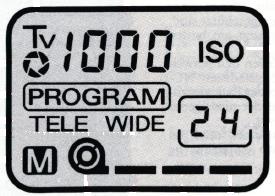 ed. What is amazing: In the operating instructions, Canon states a service life of around 5 years for the LCD display and the backup battery. With my T 80 and T 70, both still work perfectly after more than 30 years!
ed. What is amazing: In the operating instructions, Canon states a service life of around 5 years for the LCD display and the backup battery. With my T 80 and T 70, both still work perfectly after more than 30 years!
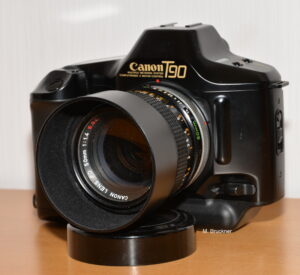
The T 90 appeared in the summer of 1986 as the top model in the series. The electronic control has again been expanded considerably: approx. 7.5x more comprehensive than with the T 70. This was not least due to the 3 electric motors that were responsible for film transport (back and forth) and for winding the shutter and mirror mechanism. The design of the camera (by Luigi Colani) also differed significantly from the other T models. The ergonomic design with a control wheel, which was also adopted by other camera manufacturers, was groundbreaking. The T 90 had a vertical metal focal plane shutter with 1/4000sec as the shortest shutter speed and 1/250sec as the flash sync speed. The exposure time could be set in half steps, multiple exposures (up to 9 pieces) were possible. The exposure metering could be switched between medium-weighted integral, partial and spot metering.  With the latter, several measurements could also be averaged. The automatic flash mode with TTL and multiple metering has been significantly expanded, for which the Speedlite 300TL flash unit was specially designed for the T 90. Many of the features of the T 90 were adopted for the subsequent EOS series with fast autofocus.
With the latter, several measurements could also be averaged. The automatic flash mode with TTL and multiple metering has been significantly expanded, for which the Speedlite 300TL flash unit was specially designed for the T 90. Many of the features of the T 90 were adopted for the subsequent EOS series with fast autofocus.

When the EOS 650 was introduced in 1987 and shortly thereafter the EOS 620, the cameras that had been offered until then suddenly looked old. The EOS (Electro-Optical System) could do almost everything better than the T 70, which it was intended to replace as a camera for dedicated amateurs. The autofocus system is fast enough even by today’s standards, the extension of the time range to automatic long-term exposures of up to 30 seconds. and the fast short time of 1/2000sec. are noted favorably. The option to switch from integral to selective measurement has been retained. Image sequences of up to three images per second were now possible. What initially deterred some users was the completely new range of lenses. The FD connection was obsolete, only the new (still current) EF lenses can be used.

Only about 2 months later, the EOS 620 was successfully introduced.
The differences to the EOS 650 are:
Illuminated display
Flash sync speed: 1/250sec
multiple exposures
fastest time: 1/4000sec
automatic bracketing
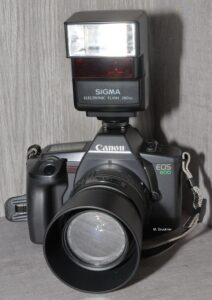
Canon caused confusion in 1989 with the introduction of the EOS 600. Advertised as the top model in the series, the camera was a mixture of the 650 and 620 with some new functions. The EOS 600 was deprived of the fast shutter, but image sequences of up to five images per second could be shot. An improved AF module was used, as was the ability to program the camera for individual functions. In automatic mode, seven selectable programs (standard, snapshot, landscape, sports, portrait, close-up and indoor shot) can be called up to make the work of the dedicated amateur easier.
Canon had made the right decisions in the long run. At the latest after the introduction of the professional EOS1, many reporters switched to the EOS track with ever faster AF speeds and other advancements.

While the first Canon EOS models for the “amateur” were high-quality machines, at the beginning of the 1990s there was a trend towards producing entry-level cameras more and more cheaply. The Canon EOS 1000 FN should serve as an example here. The grip-friendly plastic material had to give way to black hard plastic. Even the lens bayonet is made of plastic. In return, the customer could look forward to a built-in flash and new functions. A „soft focus“ program should replace a soft focus lens, a depth of field function controls the appropriate aperture for the selected distances. The pictograms of the T 80 were honored again as separately controlled programs. A special feature at Canon at that time: the film was completely wound onto the spool after being inserted and then transported back into the film cartridge frame by frame. This should ensure that if the back panel is accidentally opened, the pictures already taken will not be spoiled. All in all a well-equipped camera if only it wasn’t for the cheap plastic.

The Nikon F4, introduced in 1988, was Nikon’s first true professional camera with an integrated autofocus system. In contrast to Canon, the proven lens bayonet has been retained, in addition to the mechanical AF coupling. A special feature of the F4 is the interchangeable viewfinder system. In addition to the standard prism viewfinder, a sports viewfinder, waist level viewfinder and magnifying glass viewfinder could be used. However, only the prism viewfinder offered matrix exposure metering, the others had to be content with spot and centre-weighted metering. The shortest exposure time is 1/8000sec, which was unbelievable at the time. In automatic mode, the camera automatically exposes up to 30 seconds. When using the camera, you notice that it was built for the rough everyday life of a professional photographer. The successful design (by Giorgio Giugiaro) lacks any playfulness. If necessary, all controls can also be operated with gloves, instead of a (sensitive) display on the camera body, all information is displayed in the viewfinder. The weight was not saved either: just under 1100g for the housing alone is a challenge for freehand photography.

The amateur model F 801 was introduced three months before the introduction of the Nikon F4.
Many features of the F4 have already been anticipated here, such as the fast 1/8000s or the autofocus module. In 1991 the name was changed to F 801s because, among other things, spot metering was installed. The F 801s is a perfectly equipped camera for all those who don’t really need the interchangeable viewfinder system and the robustness of the Nikon F4. Therefore, for reasons of weight alone, many professional photographers chose the F 801
Nikon introduced an affordable mid-range model in 1994. The Nikon F70.
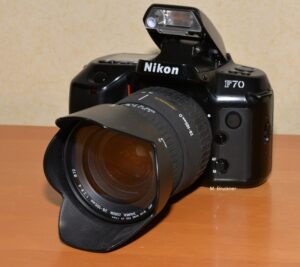
Equipped with the fast autofocus and metering system of the semi-professional F 90 and a built-in flash (guide number 14 at ISO 100), it provides the dedicated amateur photographer with numerous program functions that can also be individually modified. All settings can be controlled quickly and safely via an idiosyncratic display.
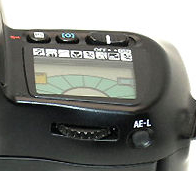 The Nikon bayonet connection gives access to the company’s own Nikkor cameras or interesting third-party suppliers. My Nikon F70 has accompanied me since 1998 without any dropouts. Annoying alone is the short warning time when the batteries are weak. As a lens I like to use the Sigma 28-105 mm zoom. Small in size, light in weight and with a large initial aperture of f/2.8, it’s almost an ideal lens for many occasions.
The Nikon bayonet connection gives access to the company’s own Nikkor cameras or interesting third-party suppliers. My Nikon F70 has accompanied me since 1998 without any dropouts. Annoying alone is the short warning time when the batteries are weak. As a lens I like to use the Sigma 28-105 mm zoom. Small in size, light in weight and with a large initial aperture of f/2.8, it’s almost an ideal lens for many occasions.
Go to roll film cameras or start page
